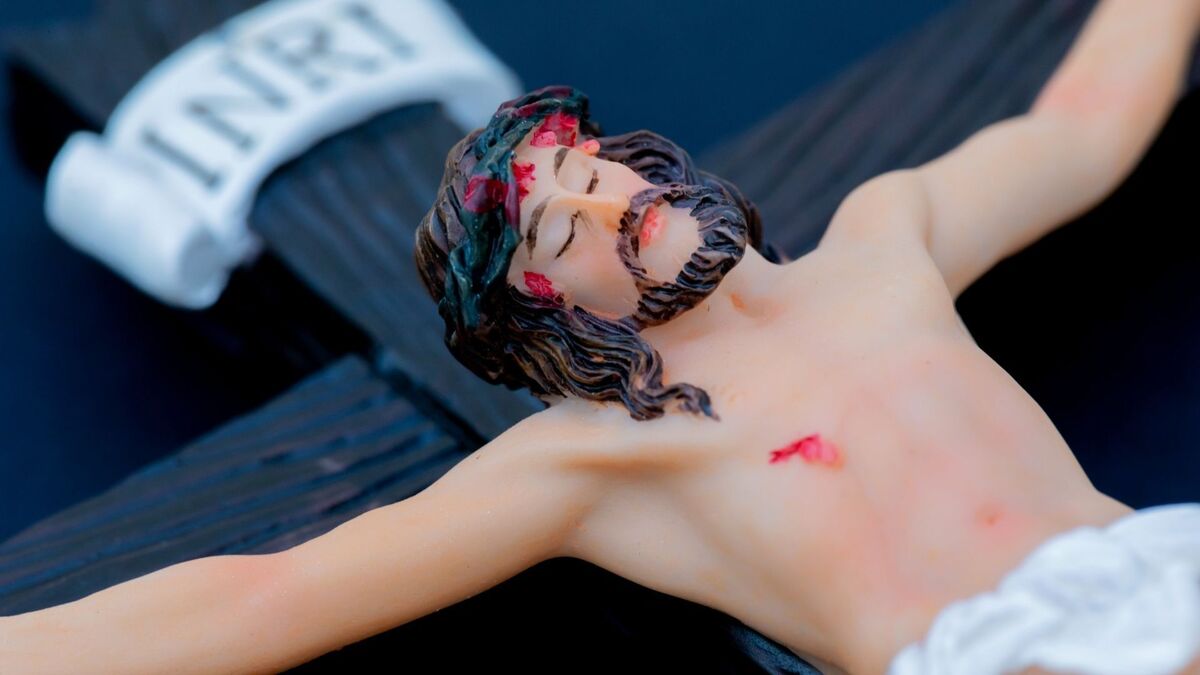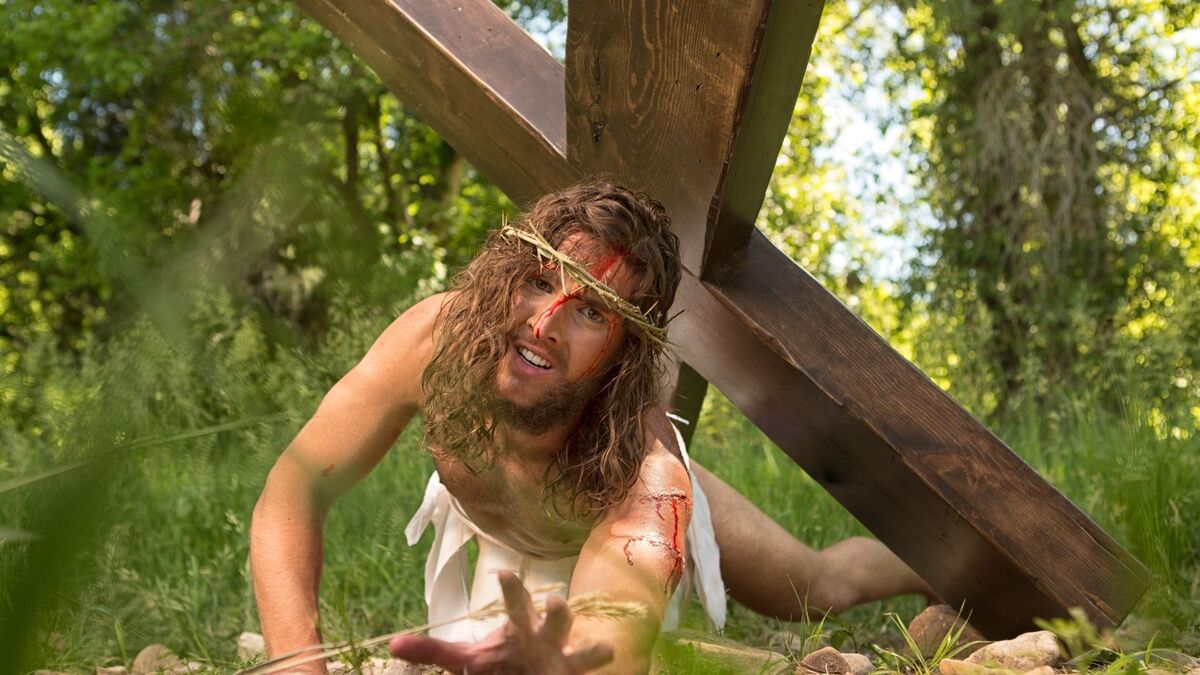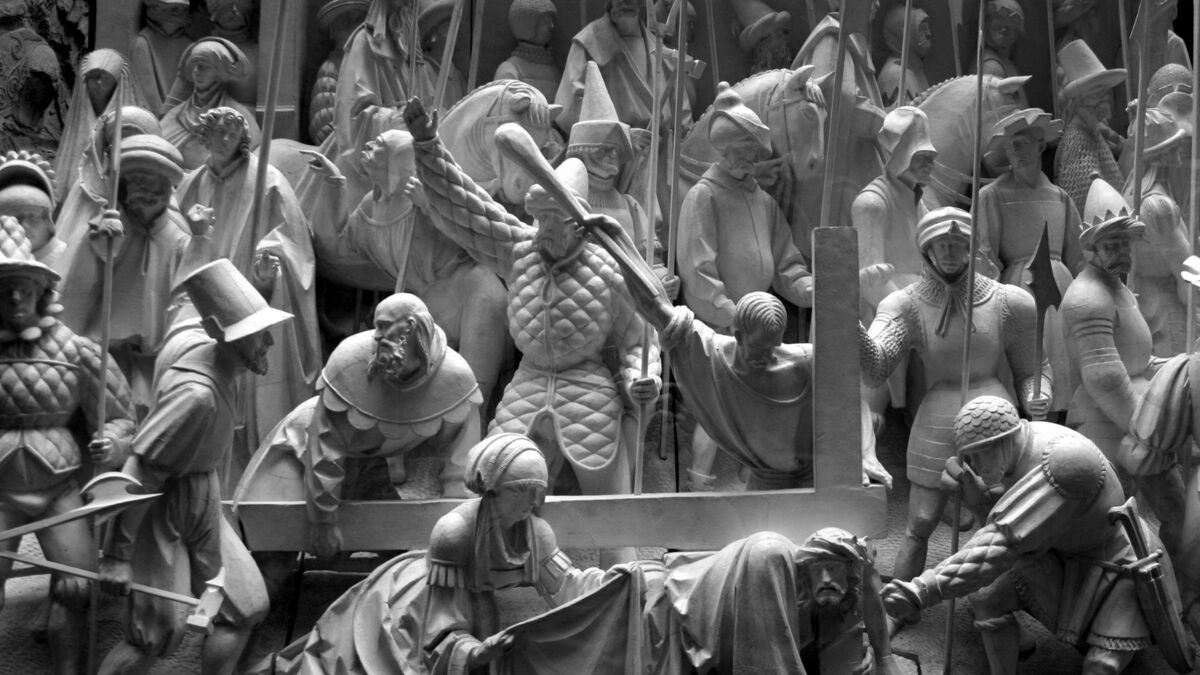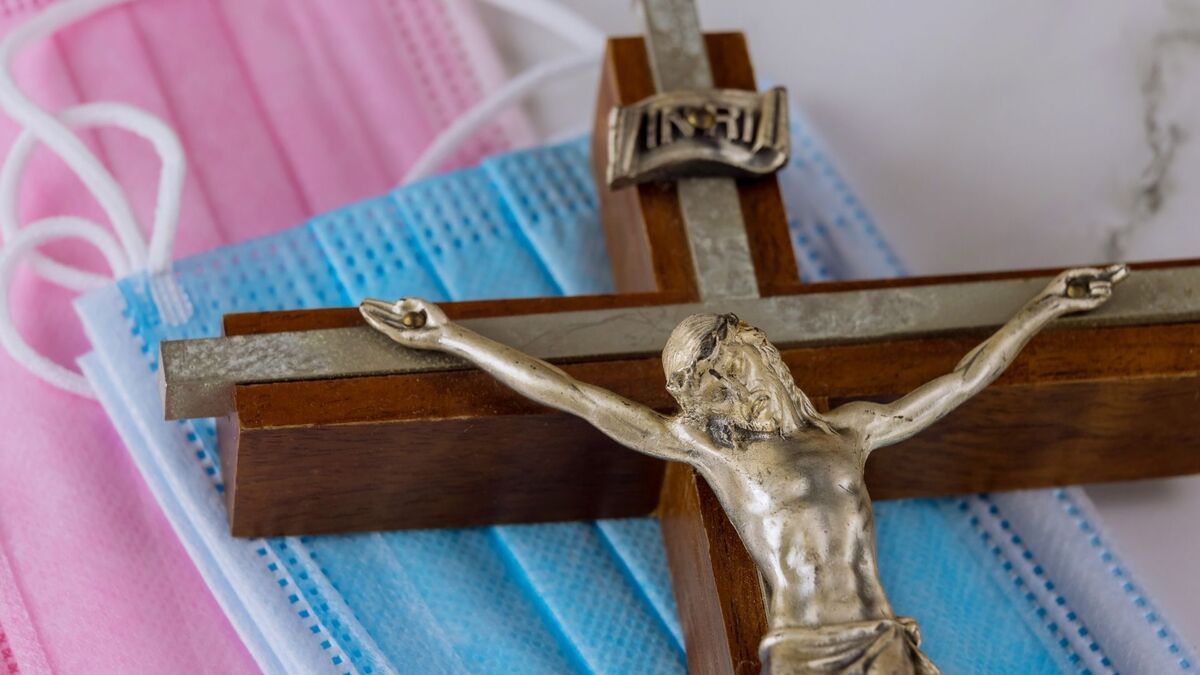Table of contents
What was Jesus' crucifixion like?

Jesus Christ is an outstanding figure in the history of all humanity. He was a great prophet and, for Christians, is the son of God. His passage on earth is so significant that the Western calendar starts counting after his birth.
The crucifixion and resurrection of Jesus revealed to the world the mercy of God and his love for all mankind. In this article we will explain in detail the story of Jesus, how his crucifixion occurred and the meaning of this act.
History of Jesus Christ

The story of Jesus has many lessons for us. It is told mainly in the four Gospels of the New Testament which were written by the disciples Matthew, Mark, John and Luke.
In these books we can discover more about Jesus' birth, childhood, youth and adult life. Follow along to find out more!
Birth of Jesus
Jesus of Nazareth was born in the year 6 BC in the city of Judea in Bethlehem, son of a carpenter named Joseph and his mother Mary. His birth occurred on December 25, that day was celebrated by the Romans the longest night of the winter solstice for that region.
His birth took place in Bethlehem due to a Roman rule imposed by Emperor Augustus, forcing subjects to register in their city of origin. Joseph's family was from Bethlehem, so he had to return to the city taking Mary still pregnant.
In Matthew's accounts, Joseph was already aware that the baby Mary had in her womb was conceived by the Holy Spirit. In addition, there was the presence of the three Magi known as Belchior, Gaspar and Balthazar, they had followed a star that led him to Bethlehem, thus witnessing the birth of Jesus.
Childhood and Youth
Herod the Great was king of the territory of Jerusalem. Aware that the "Son of God" had been born, he announced a sentence of death for all children born in Bethlehem up to two years of age. Then, to protect his son, Joseph sought refuge in Egypt and later settled in Nazareth, in the region of Galilee.
The childhood and youth of Jesus takes place in Nazareth. He made a pilgrimage with his family to Jerusalem when he was 12 years old to celebrate the Jewish Passover. When they returned from the celebrations, Mary and Joseph could not find Jesus, so they began a search that lasted three days, when they found him arguing with the priests in the Temple in Jerusalem.
At the age of 13, the bar mitzvah ritual takes place, which marks Jesus' coming of age. Being the oldest of his 4 brothers, he was considered the firstborn of the family, thus assuming a brotherly responsibility for his family until he was 20 years old.
Baptism of Jesus
Jesus Christ began to follow the Essene sect, dedicating himself body and soul to the religious cult. The Essenes believed in one God whom they called "father", in addition, they lived without accumulating any kind of goods. Jesus thus assumed a regime of voluntary poverty until his encounter with John the Baptist 10 years later.
John the Baptist preached in his words messages of transformation and redemption, using baptism as a form of purification. All who volunteered to be baptized were required to confess their sins and make vows of honesty.
His message coincided with what Jesus Christ believed, he then asks to be baptized by John. It was in the Jordan River that Jesus was purified, after which he goes on to preach and perform his miracles.
Miracles of Jesus
In his pilgrimages, he manages to convince many people to follow him as his disciples. Jesus learns of the death of John the Baptist by King Herod, so he decides to go into the desert together with his people.
At a certain point in his pilgrimage many followers become hungry. Jesus with only 5 loaves and 2 fishes operates his first miracle, known as the miracle of multiplication, when he multiplies the loaves and fishes and saves a multitude of followers from starvation.
What was the crucifixion?

Crucifixion is a practice of torture and murder that was relatively common in those days. The cruel method was used to punish thieves, murderers, and anyone who broke the law. It originated in Persia, but was used extensively by the Romans. In this section you will learn more about how this technique worked.
Persian origin
Crucifixion was a cruel and humiliating death penalty to which prisoners were subjected. The Persians hung their criminals with their arms bound without the use of the cross.
Adopted by the Romans
Roman crucifixion was a capital punishment applied only to criminals, deserters from the army, and gladiators. It was the type of punishment forbidden to any Roman citizen. Unlike the Persians, the Romans inserted the cross into this form of execution. Generally, criminals had their arms opened, bound by ropes, or nailed, to the cross.
How it worked
The crucifixion was done in such a way as to cause a slow and agonizing death. The criminals had their hands, or wrists, nailed to the wood. Then they were tied to the beam, increasing its support. Meanwhile, the feet, too, were to be nailed at the heels.
The injuries and bleeding weakened the victim and caused excruciating pain. The position of the victims and the injuries made breathing difficult due to the force of gravity. This whole process of execution could take days. Usually, due to abdominal fatigue, the victims died of asphyxiation.
How Jesus' crucifixion happened

Every detail of Jesus' crucifixion is important and carries much meaning. After all, since the night before his death Jesus was already following the divine purposes and passing on the last messages in life.
Read on and find out in detail how the crucifixion of Jesus Christ took place and understand this magnificent expression of God's love.
The Last Supper
It was during an Easter celebration with his apostles that Jesus announced that he would be betrayed by one of them, Judas Scariot. That same night, on the Mount of Olives, Jesus went to Gethsemane to pray in the company of James, John and Peter. The next day, the betrayal took place, Judas handed Jesus over for 30 pieces of silver and a kiss on the forehead.
The arrest of Jesus
Jesus is captured by Roman soldiers. At his trial he is accused of disorder, insubordination and blasphemy, for he was regarded as the son of God and King of the Jews. Because he was born in Bethlehem, he was to be transferred to Galilee to be punished by his ruler, Herod the Son.
The apostle Peter even tried to prevent Jesus from being taken prisoner from there, even reacting against the priests by cutting off the ear of one of their servants. However, he is rebuked by Jesus who says he is committed to the scriptures and the decree of God.
Jesus before the Sanhedrin
After being arrested, Jesus was taken to the Sanhedrin, where the assemblies relating to jurisdiction, religion, and politics were held. Because he had not committed any plausible crime, the Sanhedrin was unable to formulate his accusation. He ended up being convicted under false testimony, contrary to the laws of the time.
But, it was mainly because of Jesus' statement to the High Priest of the Sanhedrin that he was also accused for blasphemy. For considering himself the son of God, the one who will set humanity free.
The judgment of Jesus
After the Sanhedrin got a formal accusation about Jesus' case, he was handed over to the Roman governor of that region, known as Pontius Pilate. Several interrogations were made, even being tortured by the soldiers, yet Jesus kept quiet.
After several attempts, Pilate decided to follow a format of justice similar to a popular jury. It was then that he proposed to the people of Galilee to choose between the crucifixion of Jesus and a criminal known as Barabbas. The people demanded that Jesus be crucified.
The torture of Jesus
Moments before being judged by the people, Jesus had to endure various tortures from the soldiers. He was even flogged before and during the crucifixion. The flogging section was accompanied by shouting from all.
While carrying the cross, Jesus was naked in front of the crowd. Being constantly flogged, creating several wounds on his body. Yet, he continued carrying the cross to the place where the crucifixion would take place.
Mockery before the crucifixion of Jesus
The soldiers gathered around him. In order to mock the "King of the Jews," they dressed him in a robe that represented the robes of royalty and placed a crown of thorns on his head.
In addition to the crown, they gave him a scepter, and bowed, saying, "Hail, King of the Jews!" All who were present laughed at his image, spat on Jesus, and insulted him.
On the way to the crucifixion
The execution of Jesus Christ was to take place outside the city walls. He had already been tortured and like every condemned man, was forced to carry his own cross. It is believed that the condemned had to carry at least 13 to 18 kilos.
Jesus was very weak from the injuries he had suffered. Unable to carry the cross the whole way, the soldiers soon asked Simon to help him on the way. All along the way Jesus was being followed by a crowd. Most of them approved of the punishment, but some felt sadness for the suffering Jesus was going through.
The crucifixion of Jesus
Jesus was crucified on Golgotha, which means "place of the skull." He was crucified with two other criminals, one on His right side and the other on His left side. There it fulfilled the Scriptures as stated in Isaiah 53:12, which say that Jesus "was numbered with the transgressors."
At the time of his crucifixion, some of the soldiers offered Jesus wine with myrrh, while another offered him a sponge soaked with vinegar. He refused both. The two mixtures would bring more discomfort than benefit, for they would increase Jesus' thirst.
A plaque was placed a little above Jesus' head, on it was written: "This is Jesus, the King of the Jews". It seems that during Jesus' crucifixion he was accompanied by only a few followers, there were at his side the apostle John, his mother Mary, Mary Magdalene.
Jesus' words on the cross
In the Gospels are recorded some words proclaimed by Jesus while alive on the cross. Follow:
"Father, forgive them, for they do not know what they are doing" (Luke 23:34).
"I solemnly declare to you: today you will be with me in paradise" (Luke 23:43).
"There is your son... Here is your mother" (John 19:26,27).
"My God, My God, why hast thou forsaken me?" (Mark 15:34).
"I thirst" (John 19:28).
"It is finished" (John 19:30).
"Father, into your hands I commend my spirit" (Luke 23:46).
Jesus' death on the cross
Having been crucified at nine o'clock in the morning, Jesus persisted alive until three o'clock in the afternoon. Being that from twelve o'clock until three o'clock darkness fell over Galilee, it signified the atonement of God over the sins that Jesus Christ fulfilled with the crucifixion.
In the Holy Scriptures, the blasphemies that did not cease are also highlighted. There were people there who attacked not only Jesus, but also his divinity. Even the thieves crucified beside him insulted him. Then Jesus remained silent.
He did not stop asking his "Father" to forgive those who shared his suffering, saying this about the criminals who were beside him, until one of the thieves repented of his sins and recognized Christ as his Lord. Jesus then said: "Today you will be with me in Paradise".
Jesus surrendered his soul to God, and the way to heaven was opened. In addition, tremors struck the earth breaking rocks and opening the tomb where Jesus' body would be buried.
Jesus is taken down from the cross
After his death, one of the soldiers pierces his body with a spear, thus certifying Jesus' death. Because it was Passover season, the Jews did not want any bodies on the cross. The soldiers remove Jesus' body and break the legs of the other two criminals to hasten their deaths.
After this, the body of Jesus Christ is removed and washed. Joseph and other women faithful to Jesus take responsibility for caring for his body, preparing it for burial. Jesus' body was placed over the crack of one of the rocks that broke with the earthquake. And on Sunday morning, that same tomb was empty!
The resurrection of Jesus
The resurrection of Jesus takes place on the third day after his death. Mary, while visiting the tomb of her son, finds the stone that closed the tomb open and it was empty. After this incident, Jesus appears to Mary in her dream, thus confirming his resurrection.
There are accounts in the gospel that state that the apostles Mark and Luke reported meeting Jesus, and after that meeting, "Jesus ascends into heaven and sits at the right hand of God."
What is the significance of the crucifixion of Jesus?

The meaning of the crucifixion of Jesus goes beyond the physical aspects of his pain. At that moment, Jesus felt the weight of the sins of all men, and he who never sinned paid for the transgressions of all mankind.
In an act of love God gave His firstborn son to pay for the iniquities of men. Through this act we can hope for heavenly salvation. After all, for the greatest sins committed, the greatest sacrifice was required.
So as you study about the crucifixion of Jesus, understand it as a conscious and purposeful sacrifice made by Jesus for humanity. Remember this loving act in your prayers and give thanks for the opportunity to reunite with God in faith in Jesus.

